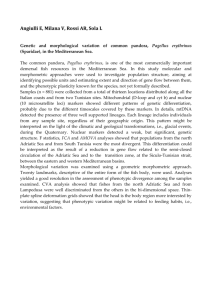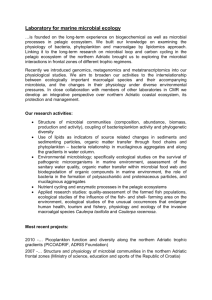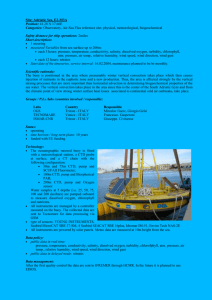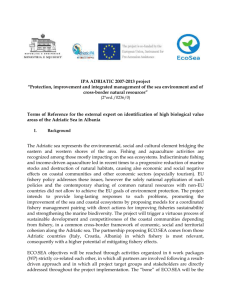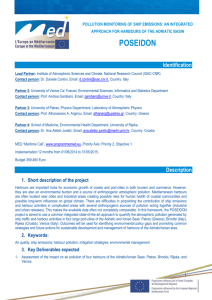Toward a Protected Maritime Environment of Adriatic Region Elson Thana
advertisement
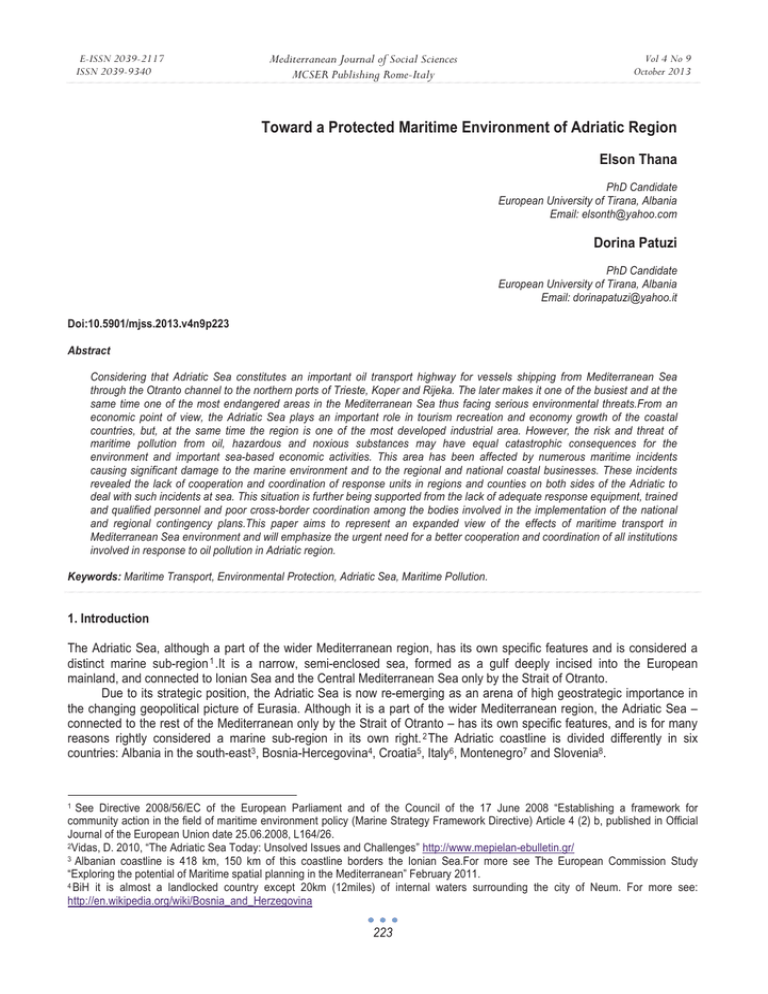
E-ISSN 2039-2117 ISSN 2039-9340 Mediterranean Journal of Social Sciences MCSER Publishing Rome-Italy Vol 4 No 9 October 2013 Toward a Protected Maritime Environment of Adriatic Region Elson Thana PhD Candidate European University of Tirana, Albania Email: elsonth@yahoo.com Dorina Patuzi PhD Candidate European University of Tirana, Albania Email: dorinapatuzi@yahoo.it Doi:10.5901/mjss.2013.v4n9p223 Abstract Considering that Adriatic Sea constitutes an important oil transport highway for vessels shipping from Mediterranean Sea through the Otranto channel to the northern ports of Trieste, Koper and Rijeka. The later makes it one of the busiest and at the same time one of the most endangered areas in the Mediterranean Sea thus facing serious environmental threats.From an economic point of view, the Adriatic Sea plays an important role in tourism recreation and economy growth of the coastal countries, but, at the same time the region is one of the most developed industrial area. However, the risk and threat of maritime pollution from oil, hazardous and noxious substances may have equal catastrophic consequences for the environment and important sea-based economic activities. This area has been affected by numerous maritime incidents causing significant damage to the marine environment and to the regional and national coastal businesses. These incidents revealed the lack of cooperation and coordination of response units in regions and counties on both sides of the Adriatic to deal with such incidents at sea. This situation is further being supported from the lack of adequate response equipment, trained and qualified personnel and poor cross-border coordination among the bodies involved in the implementation of the national and regional contingency plans.This paper aims to represent an expanded view of the effects of maritime transport in Mediterranean Sea environment and will emphasize the urgent need for a better cooperation and coordination of all institutions involved in response to oil pollution in Adriatic region. Keywords: Maritime Transport, Environmental Protection, Adriatic Sea, Maritime Pollution. 1. Introduction The Adriatic Sea, although a part of the wider Mediterranean region, has its own specific features and is considered a distinct marine sub-region 1 .It is a narrow, semi-enclosed sea, formed as a gulf deeply incised into the European mainland, and connected to Ionian Sea and the Central Mediterranean Sea only by the Strait of Otranto. Due to its strategic position, the Adriatic Sea is now re-emerging as an arena of high geostrategic importance in the changing geopolitical picture of Eurasia. Although it is a part of the wider Mediterranean region, the Adriatic Sea – connected to the rest of the Mediterranean only by the Strait of Otranto – has its own specific features, and is for many reasons rightly considered a marine sub-region in its own right. 2 The Adriatic coastline is divided differently in six countries: Albania in the south-east3, Bosnia-Hercegovina4, Croatia5, Italy6, Montenegro7 and Slovenia8. See Directive 2008/56/EC of the European Parliament and of the Council of the 17 June 2008 “Establishing a framework for community action in the field of maritime environment policy (Marine Strategy Framework Directive) Article 4 (2) b, published in Official Journal of the European Union date 25.06.2008, L164/26. 2Vidas, D. 2010, “The Adriatic Sea Today: Unsolved Issues and Challenges” http://www.mepielan-ebulletin.gr/ 3 Albanian coastline is 418 km, 150 km of this coastline borders the Ionian Sea.For more see The European Commission Study “Exploring the potential of Maritime spatial planning in the Mediterranean” February 2011. 4 BiH it is almost a landlocked country except 20km (12miles) of internal waters surrounding the city of Neum. For more see: http://en.wikipedia.org/wiki/Bosnia_and_Herzegovina 1 223 E-ISSN 2039-2117 ISSN 2039-9340 Mediterranean Journal of Social Sciences MCSER Publishing Rome-Italy Vol 4 No 9 October 2013 As to commercial shipping, the Mediterranean Sea, where transits around 30 per cent of global maritime trade, is characterized by two major patterns: one is transit only, while the other involves calling at a port in some Mediterranean country. In the Adriatic Sea, due to its geography, there is no transit, so all commercial traffic there calls at some Adriatic port. An important share of that traffic (crude oil in particular) is then further transported on-land to mid-European countries, several of them land-locked. In such a situation, the reliance on port state jurisdiction on arrival may be of considerable importance – a feature that requires enhanced sub-regional cooperation and coordination.9 Deeply incised into the European mainland, the Adriatic Sea has long been an important transport route. The reason is obvious from its geo-graphical, and indeed geopolitical, placement. On its coast highly industrially developed countries and less industrially developed mid-European countries (several of which are land-locked) gravitate naturally to the Adriatic Sea. Some of these are heavily dependent on that maritime route for their energy imports as an example Austria receives 75 per cent of its oil imports through Adriatic ports, and Bavaria in Germany even more.10 The purpose of this study is to present in an efficient way possible of positive and negative effects that maritime transport plays in the Adriatic Region. Likewise, this study aims at presenting the weaknesses and strengths of transport and will provide some ideas on where to constrain attention on enforcement of regional coordination and cooperation for the protection of the maritime environmental pollution in Adriatic Sea. 5 Croatia has the longest coastline (around 75%) of the Adriatic Sea. It goes up to 6200km including the coast of its large number of islands For recent research on the exact number of islands along the Croatian coast and coastal length measurements, see Tea Dupla_i_-Leder, Tin Ujevi_ and Mendi_ala, Coastline lengths and areas of islands in the Croatian part of the Adriatic Sea determined from the topographic maps at the scale of 1 : 25000’, Geoadria,Vol. 9, No. 1, 2004, pp. 5–32. 6 Due to the geographic position of Italy, its coastline constitutes the total western side of the Adriatic Sea and some of the northern part. The Italian coastline is around 1300km and it plays a significant role in maritime transport. 7 Montenegrin coastline expands to 294km. http://en.wikipedia.org/wiki/Geography_of_Montenegro 8 Slovenia coastline is around 45km. Its port Koper, together with Port of Trieste, is receiving a larger amount of oil coming from other ports of Mediterranean and passing through Adriatic. 9 Ibid footnote 2 10Vidas, D., 2008 “The UN Convention on the Law of the Sea, the European Union and the Rule of Law- What is going on in the Adriatic Sea” FridtjofNansensInstitutt Report 12/2008 page 4-5 224 E-ISSN 2039-2117 ISSN 2039-9340 Mediterranean Journal of Social Sciences MCSER Publishing Rome-Italy Vol 4 No 9 October 2013 The legal innovation of studying of the impact of maritime transport in Adriatic Sea will be located in two main aspects: in academic aspect which has a certain importance for the academic audiences in the fields of business, tourism and the legal and practical aspects where companies and touristic agencies as well as the population to be more informed on this mode of transport as well as the challenges of regional countries and stakeholders for strengthening their co-ordination and cooperation towards a particularly protected area of Adriatic Sea. In the following research article it will be used the qualitative approach. It will initially be done an interpretative and epistemological approach of the concept of maritime transport, later will be used a legal interpretation of the current legal system in the field of maritime environment protection which will make possible the establishment of a legal framework to enable the readers to easily understand the scope of this study and finally a description of the performer current situation by suggesting measures that should be taken in the future to determine the appropriate national and international strategies with the view to increase the coordination and cooperation of the regional countries and agencies for the protection of maritime environment and response to marine pollution. 2. Delimitation of Adriatic Sea The first maritime boundary agreement in the Adriatic Sea was between Italy and Yugoslavia in 1968.11 In that time the Adriatic was divided only by three states Yugoslavia (56%), Italy (33%) and Albania (11%). 12 After the Geo-political changes of the region and the diffraction of Yugoslavia, Slovenia and Croatia were the first two countries that started the negotiations on the new boundary 13 but the first agreement was reached in 1999 between Croatia and Bosnia Herzegovina.14 With regard to territorial sea, Italy and Croatia established a Territorial Sea of 12 Nm along their coasts15. Slovenia even its small coastline is entitled of the territorial sea but the dispute with Croatia for the small bay of Piran.16 Regarding the maritime border between Croatia and Bosnia-Herzegovina, in 1999 was signed a treaty on the maritime borders of BiH territorial sea, but the ratification of the treaty has not yet been in completed. The southern Adriatic countries Albania and Montenegro did not have any agreement or dispute in the delimitation of the border so their national jurisdiction is limited to their territorial waters.17 Regarding the Exclusive Economic Zone (EEZ) the 1982 UNCLOS entitles the coastal states to declare an EEZ to a limit of 200nm. The effect is to give the coastal states all the rights of continental shelf, plus the exclusive right to exploit the living resources within the EEZ. None of the six Adriatic states has apparently made a formal claim to an EEZ.18 Croatia has indicated that it is likely to declare such a claim and it would not be surprising if other Adriatic countries were to follow the suit.19 3. Maritime Transport in Adriatic Sea The maritime traffic in Adriatic is becoming increasingly dense lately. The increasing needs for oil, commercial trade and industry of the coastal countries and what is more important the use of Adriatic ports for transiting of goods to landlocked Scovazzi, T. (1993): The Agreements fot the Delimitation of the Italian Coastal Zones. Mediterranean Social Sciences Review, I/2, 61-74. 12 Klemencic, M. and Topalovic, D., , 2009, “The maritime boundaries of Adriatic Sea” p.312 13 Klemenþiü, M., Schofield, C. (1995): Croatia and Slovenia: The "four Hamlets” Case. Boundary and Security Bulletin, 2/4, IBRU, Durham, 65-77 14 Klemenþiü, M. (1999-2000): The Border Agreement between Croatia and Bosnia-Herzegovina: The first but not the last, Boundary and Security Bulletin, 7/4, IBRU Durham, 96-101. 15 The establishment of the territorial sea by a country is followed by an approved legislation which usually is a bilateral or multilateral agreement set in the national legislation after the approval of national Parliament. 16 This dispute led Slovenia to block Croatia’s bid to join the EU. Before Croatia has called for the border to be drown in the middle of the bay, but Slovenia feared that this would deny its ships direct passage to the high seas. See for more http://en.wikipedia.org/wiki/Croatia%E2%80%93Slovenia_border_disputes#cite_note-6 17 European Commission, 2011 “The potential of Maritime Spatial Planning in the Mediterranean Sea- Case study report: The Adriatic Sea” page 5 18 Blake, H.G., Topalovic, D., 1996 “Maritime Briefing - The Maritime Boundaries of the Adriatic Sea” Volume 1/8 - Exclusive Economic Zone (EEZ) page 14-15 19 The document passed the Croatian Parliament on 2nd February 1994. (Slobodna Dalmacija 16/4/1994) 11 225 E-ISSN 2039-2117 ISSN 2039-9340 Mediterranean Journal of Social Sciences MCSER Publishing Rome-Italy Vol 4 No 9 October 2013 countries such as Serbia, F.Y.R.O.M. Austria and central Europe is giving a special push toward the increasing use of maritime transport and in the same time the increase of the risk for pollution of maritime environment. In the "White Paper” on the European Transport Policy20the Commission predicted that there is about 40% of domestic demand for transport and maritime transport only could afford this. Commission also proposed the development of "Maritime Highway" as a true competitor of road transport. These highways became part of the Trans-European Network (TEN-T).21 The geographic shape of Adriatic Sea is characterized from a long route from south to north where the larger ships as oil tankers are navigating from straight of Otranto toward north-Adriatic ports as Trieste or Koper. These ships are frequently crossed by other ships like ferries, yachts, oil tankers or other commercial ships navigating from East to West coast of Adriatic. This situation increases the risk for maritime incidents with great impact on sea-pollution. According to the study of Det Norske Veritas (DNV), the Adriatic Sea has an accident frequency more than five times as high as the world average. The accident occurrence as related to the commercial traffic load was evaluated to be higher for the Adriatic Sea than for other highly dense shipping areas like the Mexican Gulf and the Barents Sea.22 Luckily until now there was not any serious maritime incident with potential impact on maritime environment but if it happens the separate operational response of regional countries to the incidents involving major spills it will take long time, enormous expenses and from some countries due to their luck of equipment it will be no response at all. Another important feature to maritime transport and shipping in general is the current levels of traffic in Adriatic Sea, apart from incident risks, raise serious concerns for the coastal states. That especially relates to operational oil discharges from large ships, mainly on international shipping routes that traverse the Adriatic.23 4. Maritime Environment However maritime transport, besides the positive impact, is also a serious threat to the marine environment, which is one of the main elements that affect all human lives. Protection of the marine environment is a hot topic in the focus of global organizations, the importance of which is increasing. There is the fact that the marine environment is vulnerable to pollution, but because of the dependence of human society from the marine environment pollution of the marine environment threatens many interests of society in various fields ranging from existence to recreation including tourism.24 In a macroeconomic perspective, the marine pollution threatens tourism as a major source of Gross domestic income of different states which are the backbone from which these countries are depending directly. A clean environment ensures efficient use of sand and sun, various marine water activities like diving, rowing, surfing etc. The economy of coastal countries is deeply connected with the sea, in particular the traditional sectors such as maritime transport, fisheries and coastal and marine tourism. The sea can be considered as a refuge for some of the most important treasures of the world heritage, including historic cities and virgin beaches, tourism is economically important for the Adriatic coastal areas as one of the main marine activities and rapid growth in the region. A cleaner coastal and maritime environment plays a very important role in economic incomes of a country. Its further development can be channeled through the strengthening of links between coastal states economy and cultural promotion of transnational routes, addressing concerns by developing joint seasonal touristic offers / combined programs and the promoting of the image and profile of the region as a whole, strengthening the quality of services and products offered and improving the geographical distribution of the accommodation offers. Cultural heritage in the coastal zone and in the seabed is an important element in terms of tourism development and corporate identity and thus should be promoted. By revealing the true potential for protection of maritime environment in the Adriatic Sea, promoting the economic growth and jobs for the coastal areas in the region, will require a consistent approach. The maritime activities have a significant impact on the environment on which they depend on. A long practice of developed countries has shown that intensive coastal activities are usually followed by a negative impact on the marine environment. It can lead to pollution of the sea, if waste water treatment plants do not have the capacity to handle all sewage and as a result, the discharge of a http://ec.europa.eu/transport/strategies/2011_white_paper_en.htm last time seen on 09.06.2013 http://en.wikipedia.org/wiki/Trans-European_Networks, seen on 09.06.2013 22 Summary of findings by DNV as presented in “Designation of the AdriaticSea as a Particularly Sensitive Sea Area – First draft prepared for the Meeting ofthe Joint Expert Group on PSSA, 20 April 2006” 23Vidas, D., 2008 “The UN Convention on the Law of the Sea, the European Union and the Rule of Law- What is going on in the Adriatic Sea” FridtjofNansensInstitutt Report 12/2008 page 6. 24 Churchill, R.R dhe Lowe A.V “The Law of the Sea” third edition, Manchester University Press 1999, page 328 20 21 226 E-ISSN 2039-2117 ISSN 2039-9340 Mediterranean Journal of Social Sciences MCSER Publishing Rome-Italy Vol 4 No 9 October 2013 certain amount directly into the sea. It can endanger marine species and ecosystems. Coastal protection through beach nourishment instead of using protective barriers (due to their visual appeal) may have adverse environmental effects for these reasons it is important to mention the law framework for the prevention and protection of maritime environment from maritime traffic. 5. Law framework From the earliest times after the Titanic disaster and especially after Erika25 and Prestige26 incidents that happened in Europe has highlighted the necessity for concerted action between EU and neighboring countries to ensure the highest possible safety standards for the maritime transportation of oil. It came necessary to improve and enforce the international, regional and national law related to the protection of maritime environment and the coordination and cooperation for response to maritime pollution caused by incidents at sea. There are several International and regional conventions only for the protection of Mediterranean Sea and also some sub-regional and national measures that are being implemented in the region. The “Constitution” of Law of the Sea - UNCLOS 27 contains a discipline on limits on government power, respectively, of the coastal State and the flag State, which is slightly different. In particular, the powers of the coastal State are more limited with regard on prevention and enforcement of the Exclusive Economic Zone, the coastal State may legislate in accordance with Art. 211, par. 5, only in conformity with international standards and "generally" accepted, carrying out with coercive measures only if the ship stations in one of its ports (art. 220), unless in unusual cases. In compensation the Convention recognizes to the port State the opportunity to intervene on the ship that stations, and in some cases and in certain conditions guarantees, even when the pollution did not take place in areas under its jurisdiction.28 OPRC Convention 199029 aimed to provide a global framework for international cooperation in response to major incidents or threats to marine pollution. It requests the parties of the convention to establish measures for dealing with pollution incidents either nationally or in cooperation with other countries, to report incidents to coastal authorities and provide assistance to other in case of incidents. This convention might be considered as the promoter for cooperation of the regional countries against the fight for the pollution incidents in the Adriatic Sea. - Barcelona Convention 1976. This convention together with its eight protocols are the promoters of the creation and implementation for the prevention, abating and combating pollution of the Mediterranean Sea and protection and enhancement of the marine environment in that area.30 - Sub-Regional Contingency Plan for prevention of Preparedness and response to major marine pollution incidents in the Adriatic Sea. Following the mentioned conventions the three northern Adriatic countries Italy-Slovenia-Croatia made a trilateral agreement for merging of the forces, expertise, equipment and response measures against incidents causing or likely to cause pollution in the Adriatic Sea for their respective areas. The question is why it is limited only to these countries and are not included other countries like Montenegro, Albania or Bosnia and Herzegovina? Before answering to that question it is necessary to clarify if these countries fulfill all the necessary obligations to be part of this agreement. The main obligation that other countries should fulfill is that they should have an updated national contingency plan to accomplish the national needs for response to marine pollution and after to assist other regional countries in combating the pollution in their maritime area. Secondly, if this countries have enough equipment and response measures to deal with the pollution in their respective areas and in common Adriatic Sea. National Contingency Plans. As we said to be part of trilateral agreement it is necessary that countries should have their national contingency plans. That means that Italy, Slovenia and Croatia have their plans and in the same time 25 The sunk of the tanker Erika in the coast of France on 1999 causing a major environmental disaster. For more see http://en.wikipedia.org/wiki/MV_Erika, last seen on 29 June 2013. 26 The sunk of the tanker Prestige of the coast of Galicia in 2002 polluting thousands of kilometers of the coastline. For more see http://en.wikipedia.org/wiki/Prestige_oil_spill last seen on 29 June 2013. 27 United Nations Convention on The Law of The Sea 28 Del Vecchio, Angela. Zona economica esclusiva e stati costieri, Firenze : Le Monnier, 1984 29International Convention on Oil Pollution, Preparedness, Response and Cooperation (OPRC) 1990.All regional countries except BiH are party to this international Convention. 30 Convention for the Protection of the Mediterranean Sea against Pollution, Article 4 For more see http://www.unepmap.org/index.php?module=content2&catid=001001004. Last seen 30.06.2013 227 E-ISSN 2039-2117 ISSN 2039-9340 Mediterranean Journal of Social Sciences MCSER Publishing Rome-Italy Vol 4 No 9 October 2013 they have enough equipment for response to incidents causing pollution in Adriatic Sea. Republic of Montenegro31 and Albania32 already fulfill the two abovementioned criteria. They both have updated national contingency plans that were drafted with the assistance of REMPEC33. 6. Conclusion However, the problem of marine pollution has become increasingly severe due to the increasing technological progress. This progress could not be resolved through a few rules mentioned above. Despite the fact that Adriatic is a semi closed Sea it plays a very important role for the economy of the region. It serves as a route for transport of the goods and passengers from other international ports to the ports of Adriatic. Being aware that a serious marine pollution incident may significantly damage the Adriatic ecosystem and economic activities including in particular tourism and industry generation it bring the importance the enforcement of several measures that should be implemented for the better protection of Adriatic Sea environment. The unification of the regional law framework for response to maritime pollution and the drafting of common regulations is one of the most important steps that should be taken. This would make possible the ability of all regional countries to use the same laws and regulations for the common goal the protection of common Adriatic Sea from Pollution including the simplification of the cross boarding procedures and diplomatic clearances. Another measure that should be taken in consideration by the countries is the drafting of new bilateral and multilateral agreements for cooperation and coordination of the work in case of pollution incidents. These agreements will enhance regional coordination and cooperation of the participating countries by pooling resources and expertise together, not only to be cost-effective, but to give the neighboring countries the opportunity to share and further develop professional skills and technical expertise. For a prompt and efficient response to marine pollution incidents, exercising national capabilities, including pollution response equipment and personnel, and the development of the conformity of applicable international regulations will be important. Functional plans and well-coordinated and trained capacities will also reduce the risk of marine pollution incidents and thereby contribute to the protection of the Adriatic Environment. It is also necessary to set up a common database on the state of readiness and spatial distribution of pollution preventing equipment along the Adriatic coasts as well as the improvement of the operational instruments to cope with the environmental and technological hazards. Some important steps should be taken in the field of maritime safety. If there is no safety in navigation there is no cleaner environment. That means that all regional countries should establish a communication and reporting network for the exchange of the information between countries for the vessels shipping through Adriatic Sea, the goods carrying especially if it is oil or other hazardous and noxious substances, and their destination and the improvement of the early warning system – through a joint radar monitoring program based on a set of radar systems and the consequent the capacity of the entrusted Euro-region actors to identify potential sources of risks menacing ecosystems (mainly located in the most sensitive economic poles of Adriatic) and trigger coordinated intervention procedures. Bibliography Del Vecchio, Angela. Zona economica esclusiva e stati costieri, Firenze: Le Monnier, 1984 Directive 2008/56/EC of the European Parliament and of the Council of the 17 June 2008 “Establishing a framework for community action in the field of maritime environment policy (Marine Strategy Framework Directive), Article 4 (2) b, Official Journal of the European Union,25.06.2008, L164/26. DNV “Designation of the Adriatic Sea as a Particularly Sensitive Sea Area – First draft prepared for the Meeting of the Joint Expert Group on PSSA, 20 April 2006 International Convention on Oil Pollution, Preparedness, Response and Cooperation (OPRC) 1990 European Commission, 2011 “The potential of Maritime Spatial Planning in the Mediterranean Sea- Case study report: The Adriatic Sea” Montenegrian Contingency Plan was aproved in 2011 and now due to some changes in maritime administration, it is now subject of some updates. 32 Albanian National Contingency Plan was drafted and approved in July 2012 33 The Regional Marine Pollution Emergency Response Center for the Mediterranean Sea (REMPEC). The main objective of REMPEC is to assist Mediterranean coastal states in ratifying, transposing, implementing and enforcing international maritime conventions related to the prvention of, preparedness for and response to marine pollution from ships. For more see http://www.rempec.org/. Last seen 30.06.2013 31 228 E-ISSN 2039-2117 ISSN 2039-9340 Mediterranean Journal of Social Sciences MCSER Publishing Rome-Italy Vol 4 No 9 October 2013 The European Commission Study “Exploring the potential of Maritime spatial planning in the Mediterranean”, February 2011 Klemenÿiý, M., Schofield, C. (1995): Croatia and Slovenia: The "four Hamlets” Case. Boundary and Security Bulletin, 2/4, IBRU, Durham, Klemenÿiý, M. (1999-2000): The Border Agreement between Croatia and Bosnia-Herzegovina: The first but not the last, Boundary and Security Bulletin, 7/4, IBRU Durham Klemencic, M. and Topalovic, D., , 2009, “The maritime boundaries of Adriatic Sea” Scovazzi, T. (1993): The Agreements fot the Delimitation of the Italian Coastal Zones. Mediterranean Social Sciences Review, I/2, Tea Dupla. 2004, Coastline lengths and areas of islands in the Croatian part of the Adriatic Sea, Geoadria,Vol. 9, No. 1, United Nations Convention on The Law of The Sea (UNCLOS),1982 Vidas, D., 2008 “The UN Convention on the Law of the Sea, the European Union and the Rule of Law- What is going on in the Adriatic Sea”, Fridtjof Nansens Institutt Report, 12/2008 Vidas, D. 2010, “The Adriatic Sea Today: Unsolved Issues and Challenges” Websites http://en.wikipedia.org/wiki/MV_Erika http://en.wikipedia.org/wiki/Prestige_oil_spill http://ec.europa.eu/transport/strategies/2011_white_paper_en.htm http://en.wikipedia.org/wiki/Trans-European_Networks http://en.wikipedia.org/wiki/Geography_of_Montenegro http://en.wikipedia.org/wiki/Bosnia_and_Herzegovina http://www.mepielan-ebulletin.gr/ http://www.unepmap.org/index.php?module=content2&catid=001001004 http://adriatic12.com/ http://www.rempec.org/ 229
